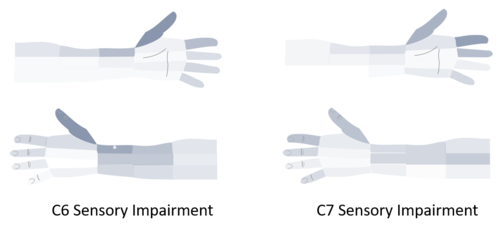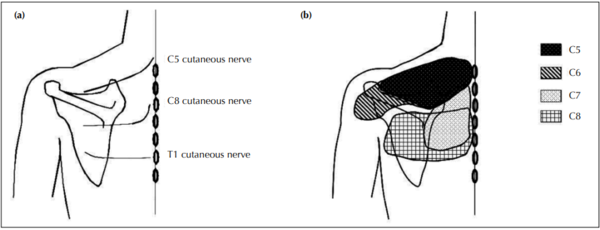Cervical Radicular Pain and Radiculopathy: Difference between revisions
No edit summary |
No edit summary |
||
| Line 1: | Line 1: | ||
{{stub}} | {{stub}} | ||
==Definitions== | |||
{{Main|Cervical Spine Pain Definitions]] | |||
Cervical radiculopathy is characterised by objective loss of neurologic function. Loss of function is some combination of sensory loss, motor loss, or impaired reflexes, in a segmental distribution. Pain is not a component of radiculopathy, and so is distinguished from cervical radicular pain. | |||
==Aetiolopathophysiology== | |||
Not much is known about the causes and mechanisms of cervical radicular pain. The literature often uses the term cervical radiculopathy, but radiculopathy and radicular pain are not synonymous. | |||
Radiculopathy arises from either direct compression of a cervical spinal nerve or root, or by ischaemia from vascular injury to their blood supply. There is a conduction block along the affected axons which results in sensory or motor loss. Compression of axons, including those of the lumbar nerve roots, does not cause activity in nociceptive afferent fibres. Meanwhile, compression of a dorsal root ganglion does cause pain through activation of A-beta and C fibres. The causes of cervical radicular pain cannot therefore be attributed to the same causes as those of radiculopathy. | |||
In contrast to compression, it is thought that inflammation of the cervical nerve roots is the underlying mechanism through which radicular pain occurs. | |||
==Clinical Features== | ==Clinical Features== | ||
Cervical radiculopathy is characterised by negative objective signs: sensory loss, motor loss, or impaired reflexes, in a segmental distribution. | |||
===Limb Pain=== | ===Limb Pain=== | ||
[[File:C6 and C7 radicular pain.png|thumb|right|500px|Based off data from Rainville et al. <ref>{{#pmid:26253986}}</ref> The asterix indicates the only area where there is a statistical difference, with impaired in the distal radial aspect of the dorsal forearm more common in C6 than C7 radiculopathy.]] | [[File:C6 and C7 radicular pain.png|thumb|right|500px|Based off data from Rainville et al. <ref>{{#pmid:26253986}}</ref> The asterix indicates the only area where there is a statistical difference, with impaired in the distal radial aspect of the dorsal forearm more common in C6 than C7 radiculopathy.]] | ||
Revision as of 19:52, 24 May 2021
Definitions
{{Main|Cervical Spine Pain Definitions]] Cervical radiculopathy is characterised by objective loss of neurologic function. Loss of function is some combination of sensory loss, motor loss, or impaired reflexes, in a segmental distribution. Pain is not a component of radiculopathy, and so is distinguished from cervical radicular pain.
Aetiolopathophysiology
Not much is known about the causes and mechanisms of cervical radicular pain. The literature often uses the term cervical radiculopathy, but radiculopathy and radicular pain are not synonymous.
Radiculopathy arises from either direct compression of a cervical spinal nerve or root, or by ischaemia from vascular injury to their blood supply. There is a conduction block along the affected axons which results in sensory or motor loss. Compression of axons, including those of the lumbar nerve roots, does not cause activity in nociceptive afferent fibres. Meanwhile, compression of a dorsal root ganglion does cause pain through activation of A-beta and C fibres. The causes of cervical radicular pain cannot therefore be attributed to the same causes as those of radiculopathy.
In contrast to compression, it is thought that inflammation of the cervical nerve roots is the underlying mechanism through which radicular pain occurs.
Clinical Features
Cervical radiculopathy is characterised by negative objective signs: sensory loss, motor loss, or impaired reflexes, in a segmental distribution.
Limb Pain

It is not possible to distinguish C6 from C7 radiculopathy with a sensory examination of the so-called dermatomes.
Shoulder Girdle Pain

(b) The site of radicular pain involving the C6 root overlaps with that of the C5 root, and also involves the posterior deltoid.[2]
Scapular and shoulder pain can occur with cervical nerve root irritation. This is analogous to the common finding of buttock pain with lumbar radicular syndrome. Scapular pain usually precedes pain in the arm and/or fingers. The site of scapula pain may be a helpful data point in determining the affected level, but it is important to consider the more common cervical facet joint pain. Scapula pain may occur through the medial branches of the dorsal rami of the cervical nerves. Mizutamari et al found that there was no cutaneous course of C6 and C7 and that these patients complained of deep scapula pain only. This is compared to patients with C5 and C8 lesions having both superficial and deep pain.[2]
Mizutamari et al found the following pain referral pattern:
| Nerve root | Shoulder Girdle Region | Deep or superficial |
|---|---|---|
| C5 | Suprascapular region | Superficial and deep pain |
| C6 | Suprascapular to posterior deltoid region | Deep pain |
| C7 | Interscapular region | Deep pain |
| C8 | Interscapular and scapular regions | Superficial and deep pain |
References
- ↑ Rainville et al.. Exploration of sensory impairments associated with C6 and C7 radiculopathies. The spine journal : official journal of the North American Spine Society 2016. 16:49-54. PMID: 26253986. DOI.
- ↑ 2.0 2.1 Mizutamari et al.. Corresponding scapular pain with the nerve root involved in cervical radiculopathy. Journal of orthopaedic surgery (Hong Kong) 2010. 18:356-60. PMID: 21187551. DOI.
Literature Review
- Reviews from the last 7 years: review articles, free review articles, systematic reviews, meta-analyses, NCBI Bookshelf
- Articles from all years: PubMed search, Google Scholar search.
- TRIP Database: clinical publications about evidence-based medicine.
- Other Wikis: Radiopaedia, Wikipedia Search, Wikipedia I Feel Lucky, Orthobullets,


